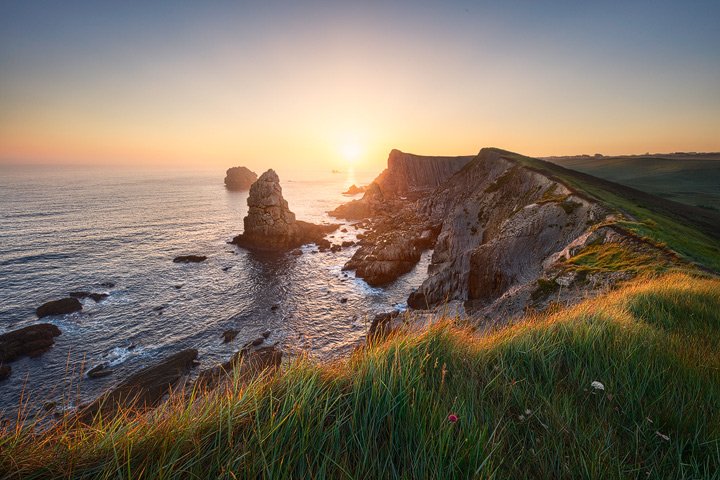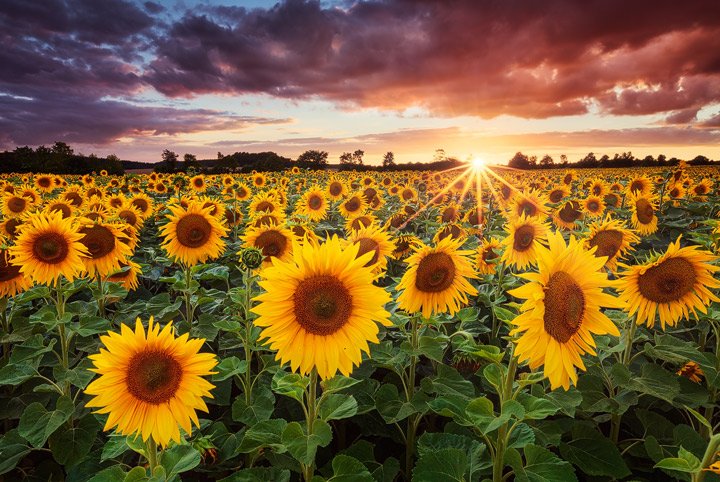In today’s article I want to share a tutorial video, in which I show you how to use focus stacking in landscape photography. I show you both my in the field technique and my post processing workflow in Photoshop.
But first things first: what exactly is focus stacking and why do I use it? In landscape photography, when I want to get a dynamic composition, I often try to get very close to the foreground elements in the frame. Normally, if I want to increase the depth of field in order to get everything sharp in such a situation, what I could to do is to use smaller apertures.

But even using the smallest available aperture often isn’t enough. And if it was, using it would have a negative effect on the overall sharpness and might be counterproductive to the sharp photo I want to achieve.
The reason for this is the so called diffraction, which causes photos taken with too small apertures to look softer and less detailed than photos taken at apertures between f/5.6 and f/11 for example. To get a good compromise between depth of field and overall sharpness l usually stick to f/9.5 or f/11.
Once the depth of field I get by using those apertures isn't enough for the scene at hand, I simply take multiple photos and shift the focus between each of them. This is called focus stacking. In the video below I go a bit more into the details and also show more examples.
As you can see, focus stacking isn’t very complicated. But once there are moving elements in the frame it can get tricky. I can try to bump up the ISO and perform the stacking as fast as possible. But it’s very likely that the moving elements in the photos will not align perfectly and the blending will be very hard and might require some additional cloning work.
In such cases it might be better to use a smaller aperture. It’s a compromise, but it’s better to get a photo of medium sharpness than no photo at all.
An alternative would be the use of a Tilt-Shift lens. Such lenses allow to extend the area of sharpness in a photo by tilting the focal plane. But such lenses aren’t cheap and they also have their limits.

In the end the most important thing is, as with all new techniques, to practice. While in the beginning focus stacking might slow you down a bit, over time it will become a nearly subconscious action. And it will free you from the decision of where to focus because you are taking multiple photos with different focus anyway.
But enough talk. Now it’s time for you to head out and take some photos :-)




Great guide! Such a useful technique to have in the back pocket. Nothing is more disappointing than getting home and seeing that your amazing photo isn't focused all the way into the scene (if it's a landscape photo).
@originalworks
World of Photography Beta V1.0
>Learn more here<
Wednesday.
You have earned 5.80 XP for sharing your photo!
Daily photos: 1/2
Daily comments: 0/5
Multiplier: 1.16
Server time: 21:24:52
Total XP: 191.81/200.00
Total Photos: 17
Total comments: 4
Total contest wins: 2
Follow:
Join the Discord channel: click!
Play and win SBD:
Learn how to program Steem-Python applications:
Developed and sponsored by: Thank you for participating in #landscapephotography, the weekly selection will be released on @photocontests@fairlotto@steempytutorials @juliank
Killer photo!!!
Thanks you
Great guide!! Awesome pictures and useful tips. I prefer to have a single exposure, but sometimes stacking can be a great trick!
I'd also love to get it all with one photo sometimes... but somehow I always end up with 5-10 for a scene - focus stacking, exposure blending and so on ;-) Has become quite of a habit gg
Focus stacking has always facinated me... was happy to have the auto feature on the D850 but haven't really used it. I think the trick for me is to continue to think about use case scenarios or try to push myself to find shots with a really close element.
But even so seeing as I don't want to own integrate photoshop into my workflow I do hope that lightroom will add the feature one of these days... seems like something they could handle.
Just like panoramas when lightroom added it I started to go crazy with it.
I started doing focus stacking heavily on the cross-Canada trip, so that when I got the D850 midway through I really appreciated having that feature (it's a great idea but I'm still surprised they thought to put it into a camera like this). And YES, I like how it pushes you to get closer to stuff - which increases the difficulty level and time involved in crafting a landscape image, but has a larger payoff if you can nail it.
Ah you guys with the D850... Now you're not only spoiled with DR but also with even more cool features ;-)
Focus stacking in the field is always worth it. If in the end I don't need the additional photos I can just delete them but I can be sure to have nailed the focus at least in one frame. Hyperfocal Distance doesn't seem to work for me ;-)
@jarvie : even if you don't want to integrate PS into the workflow yet, I think there are tools to do the stacking for you so you can stay in Lr with your processing. But I'm sure it's just a question of time until they add it to LR.
I prefer manual stacking though
Hehe. DR is still the most important thing though. As awesome as the D850 is, I haven't edited enough of my photos from the D850 yet to make the judgment call of whether it's worth the extra $2000 over the D750, weighing the extra features against a better lens or more travel.
And good point about focus stacking tools - there's probably one that will work in concert with Lightroom. My experience with PS though is that it never gets the focus stacking quite right - manual adjustment helps.
Great post, you should try posting your videos on Dtube!